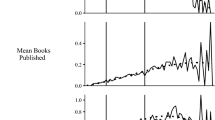Abstract
Research suggests that new doctoral graduates face increased publication pressure to achieve tenure: doctoral programs may have also increased this expectation. We examined whether faculty graduating before and after the year 2000 differed significantly in total publications, peer-reviewed publications, and first-authored publications as of the year they graduated with their doctoral degrees along with peer-reviewed publications as of tenure. A sample of 197 curriculum vitae was retrieved from educational psychology departmental websites across the 24 universities; vitae were coded for year the faculty member completed his/her doctorate and total number of publications, number of peer-reviewed publications and number of first-authored, peer-reviewed publications. Results indicated that faculty who graduated in the year 2000 and beyond had a significantly greater number of total publications—more peer-reviewed publications, more first-authored, peer-reviewed publications as of the year they graduated with their doctoral degrees, along with more peer-reviewed publications as of tenure. Publication productivity among doctoral graduates of educational psychology programs at research universities before and after the year 2000.

Similar content being viewed by others
References
Adams, K. (2002). What colleges and universities want in new faculty. Washington, DC: Association of American Colleges and Universities.
American Psychological Association (APA) (2009). Publication manual of the American Psychological Association. Washington, DC: Author.
Byrnes, J. P., & McNamara, C. C. (2001). Evaluating doctoral programs in the developmental sciences. Developmental Review, 21(3), 326–354.
Carnegie Foundation for the Advancement of Teaching (2005). Classifications. Retrieved on October 1, 2009, from http://www.carnegiefoundation.org/classifications/index.asp.
Cohen, J. (1988). Statistical power analysis for the behavioral sciences (2nd ed.). Hillsdale, NJ: Lawerence Earlbaum Associates.
Correia, A., & Teixeira, J. (2005). Reforming scholarly publishing and knowledge communication: From the advent of the scholarly journal to the challenges of Open Access. Information Services & Use, 25(1), 13–21.
Davidson, L. (2005). The End of Print: Digitization and Its Consequence—Revolutionary Changes in Scholarly and Social Communication and in Scientific Research. International Journal of Toxicology, 24(1), 25–34.
DeLong, J. B., & Magin, K. (2006). A short note on the size of the dot-com bubble. NBER Working Paper No. W12011. Available at SSRN: http://ssrn.com/abstract=881245.
Fox, M. (1992). Research, teaching, and publication productivity: Mutuality versus competition in academia. Sociology of Education, 65(4), 293–305.
Garvin, D. (1980). The economics of university behavior. New York, NY: Academic.
Hurd, J. (2004). Scientific Communication: New Roles and New Players. Science & Technology Libraries, 25(1/2), 5–22.
Joy, S. (2006). What should I be doing, and where are they doing it?: Scholarly productivity of academic psychologist. Perspectives on Psychological Science, 1(4), 346–364.
Kopak, R., & Chiang, C. (2009). An interactive reading environment for online scholarly journals. OCLC Systems & Services, 25(2), 114–124.
Luzón, M. (2007). The Added Value Features of Online Scholarly Journals. Journal of Technical Writing & Communication, 37(1), 59–73.
Mabe, M. (2003). The growth and number of journals. Serials: The Journal for the Serials Community, 16(2), 191–197.
Mayrath, M. C. (2008). Attributions of productive authors in educational psychology journals. Educational Psychology Review, 20(1), 41–56.
Public Knowledge Project (PKP) (2009). Open Journal Systems. Retrieved October 15, 2009 from: http://pkp.sfu.ca/?q=ojs.
R Development Core Team (2009). R: A language and environment for statistical computing. Retrieved October 15, 2009 from: http://www.R-project.org.
Simonton, D. (2003). Qualitative and quantitative analyses of historical data. Annual Review of Psychology, 54(1), 617.
SPSS Inc (2008). SPSS Base 16.0 for Windows User's Guide. Chicago: SPSS Inc.
US News & World Report (2010). Best colleges 2010. Retrieved April 1, 2010 from: http://colleges.usnews.rankingsandreviews.com/best-colleges.
Author information
Authors and Affiliations
Corresponding author
Rights and permissions
About this article
Cite this article
Barnard-Brak, L., Saxon, T.F. & Johnson, H. Publication Productivity among Doctoral Graduates of Educational Psychology Programs at Research Universities before and after the Year 2000. Educ Psychol Rev 23, 65–73 (2011). https://doi.org/10.1007/s10648-010-9146-3
Published:
Issue Date:
DOI: https://doi.org/10.1007/s10648-010-9146-3




